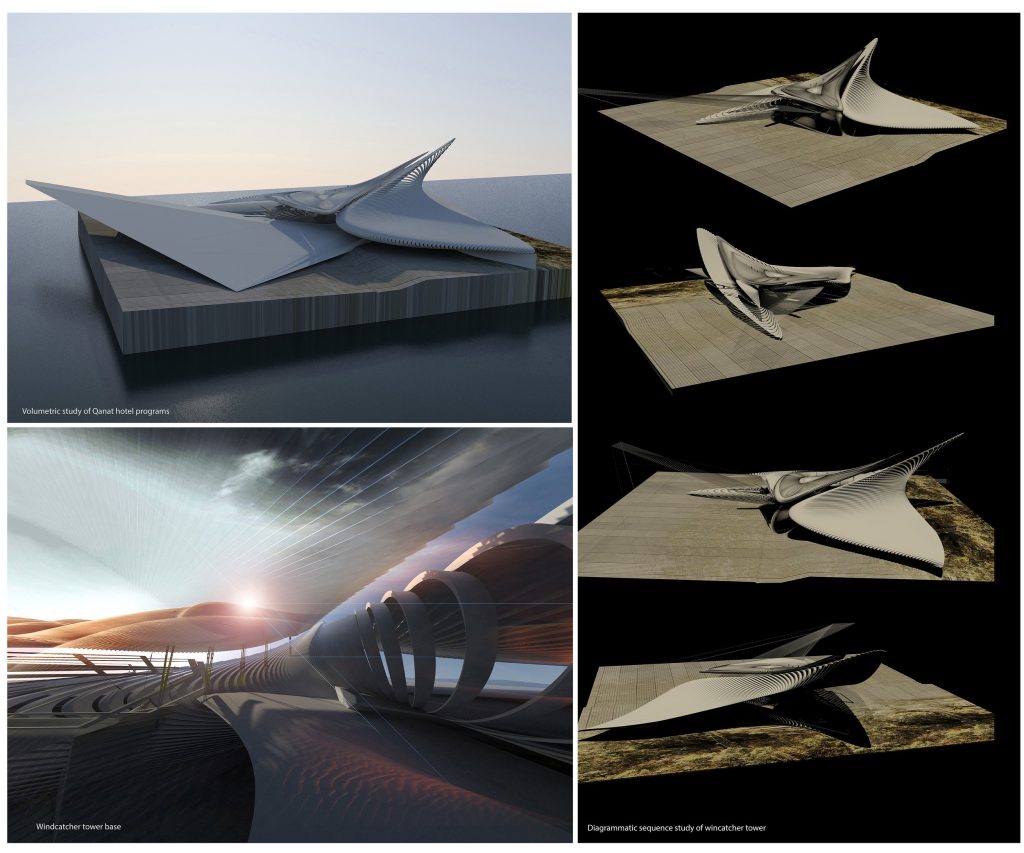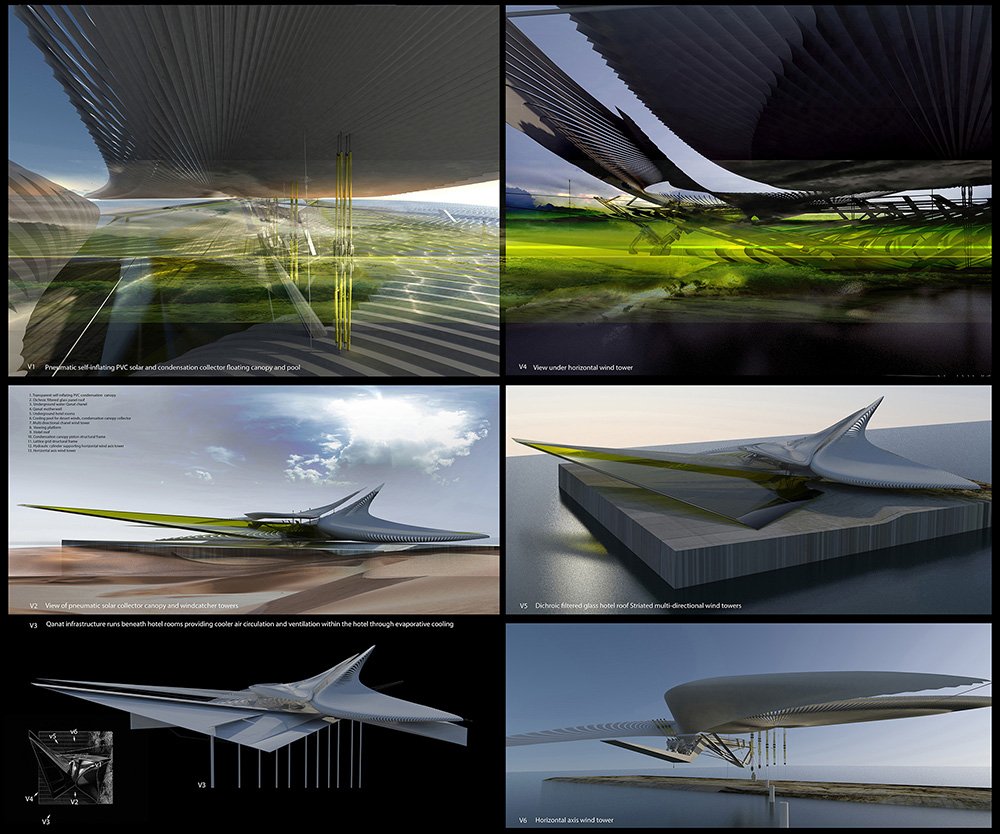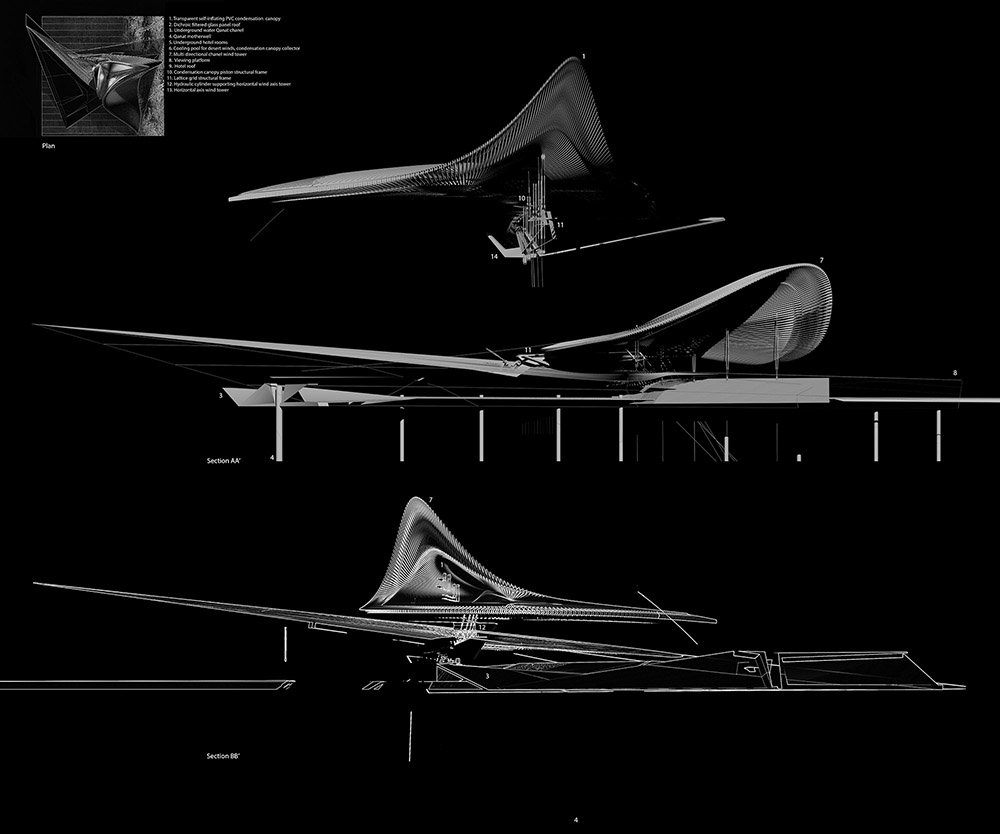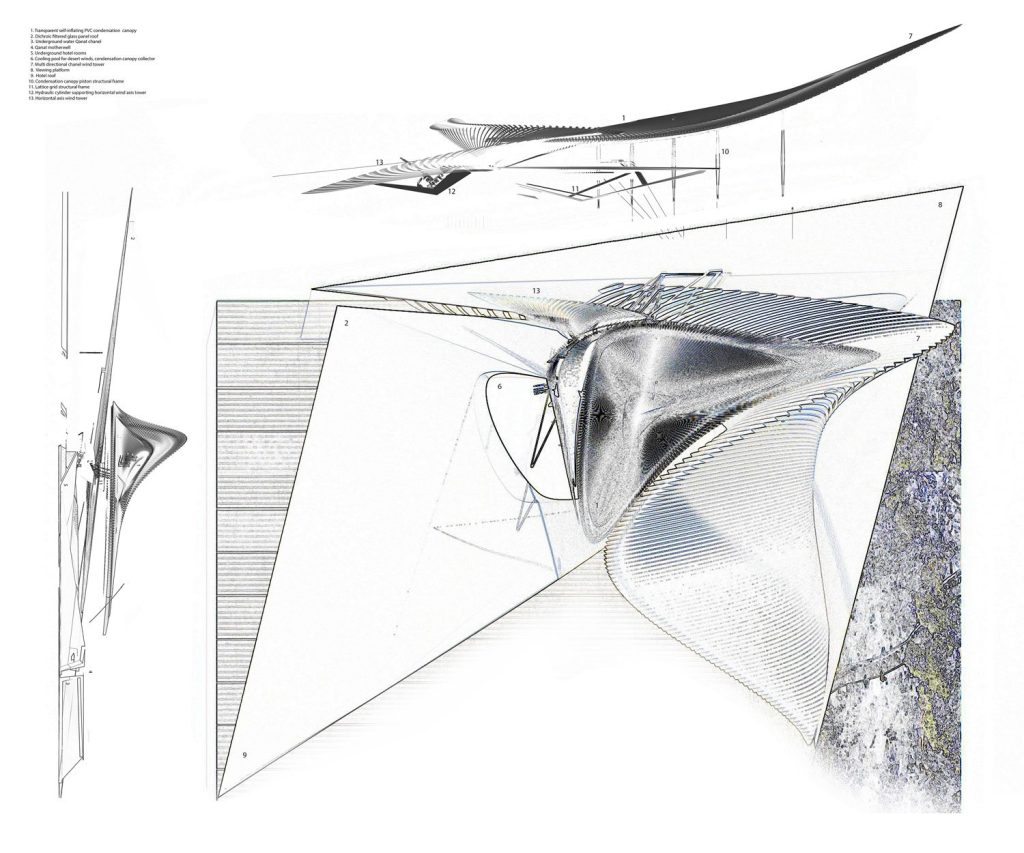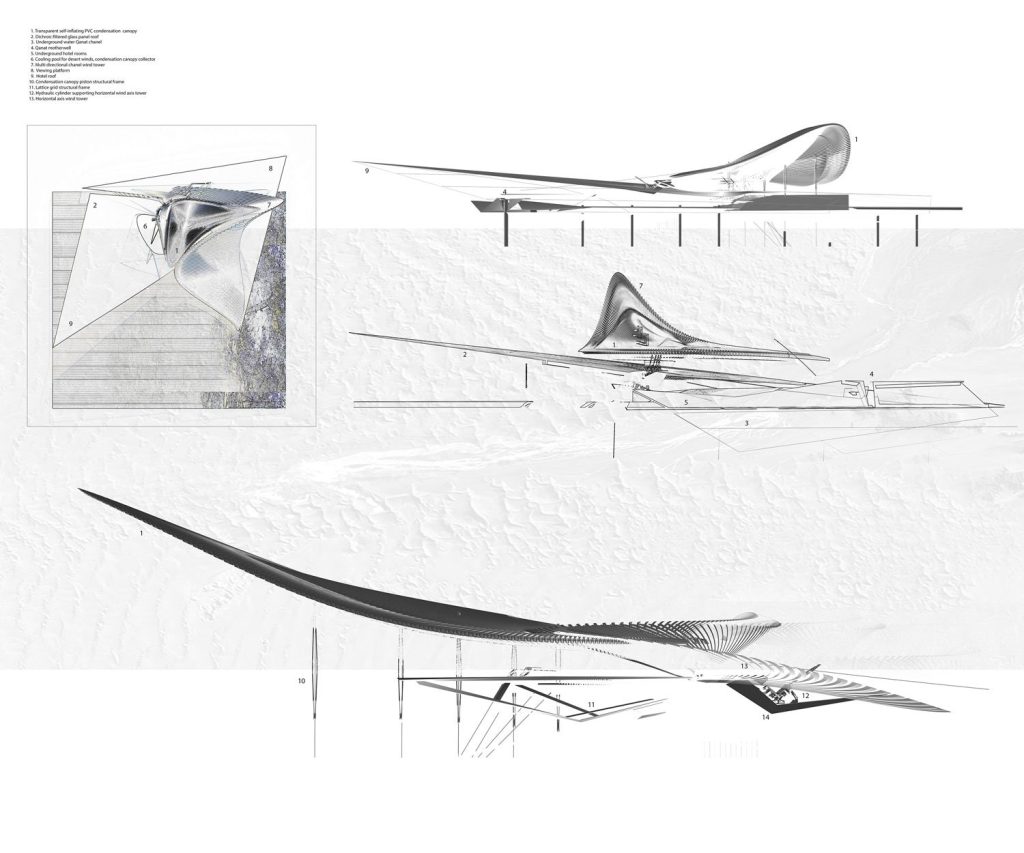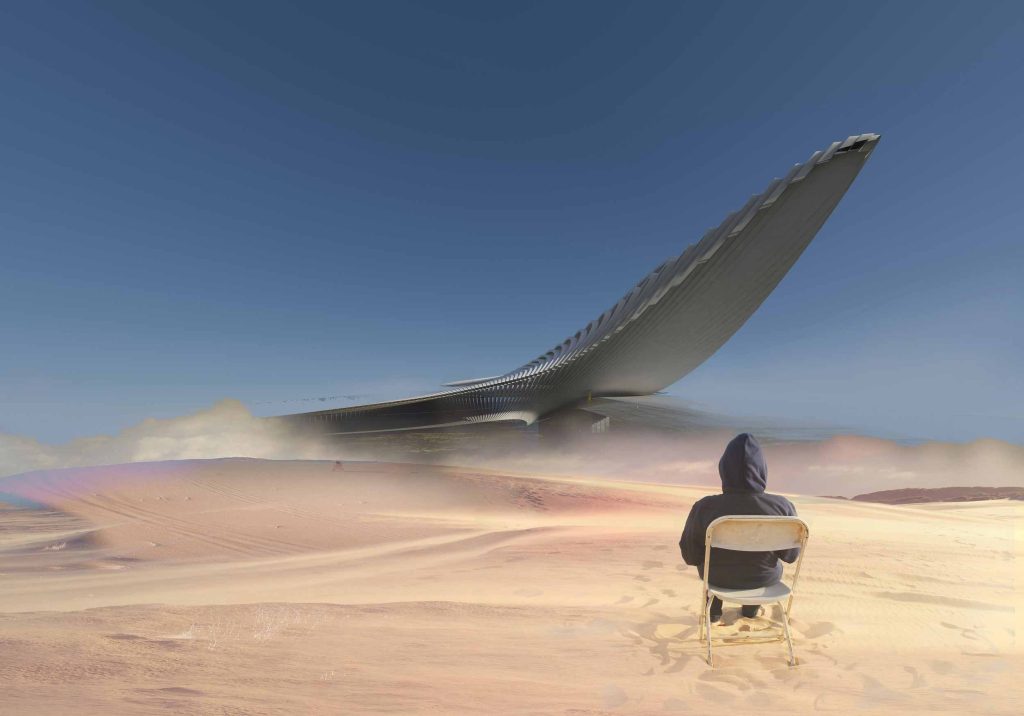
The hotel’s location is Makran, a semi-desert coastal strip stretched along with south-eastern Iran to Pakistan’s Baluchistan and borders the coasts of the Persian Gulf and Sea of Oman. It is home to the strategic critical port of Chabahar that sits in the vicinity. The hotel will make use of an existing yet currently redundant qanat, with the aim to repurpose it as part of the hotel’s infrastructure. This hotel project is an eco-tourism resort that focuses on the context’s environmental conditions using this to inform the design process and the architectural strategy.
The main considerations are that of using wind, heat, and aquifers to design a modern wind tower and Qanat system, referencing the traditional Persian construction methods to cool and ventilate desert buildings by circulating and recycling warm arid desert air. The hotel appeals to the ecologically and socially conscious individuals where the primary attractions are cultural heritage, social, economic and environmental needs that are prioritised to ensure sustainable development.
Ecotourism prioritises programs that reduce the negative conditions of conventional tourism and its effects on the environment by encouraging and integrating the cultural integrity of local people. Recycling, renewable energy and sustainability establishes economic opportunities for local communities by using architecture to define and introduce new cross-programmatic typologies.
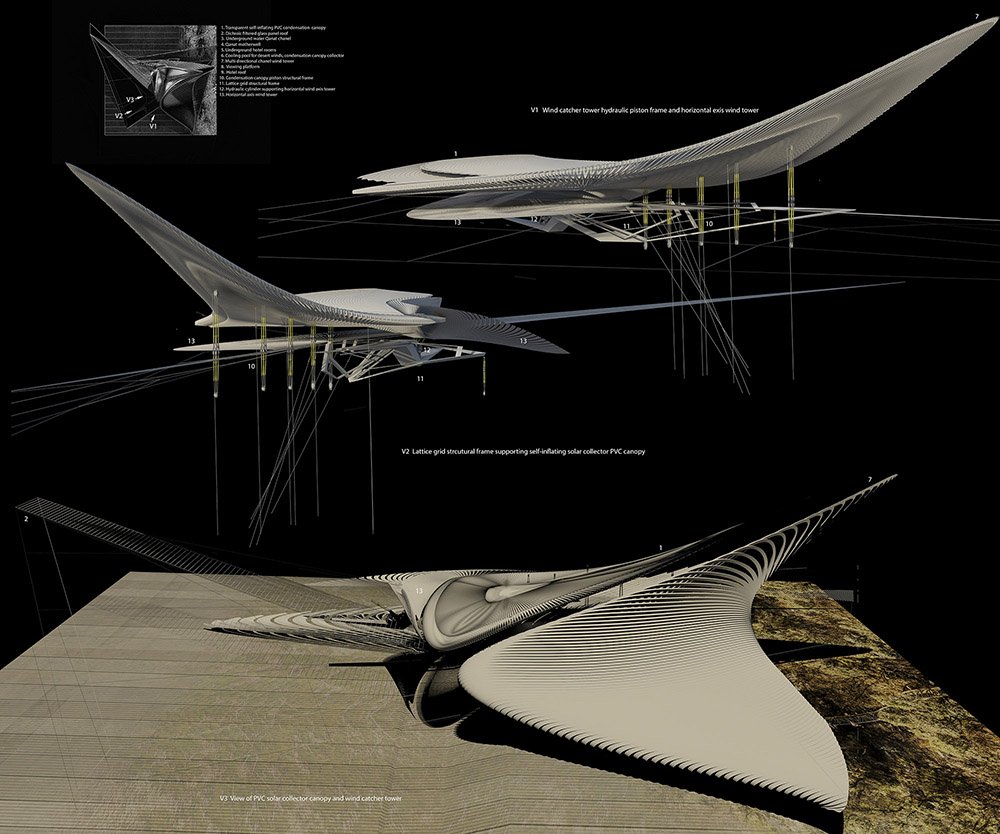
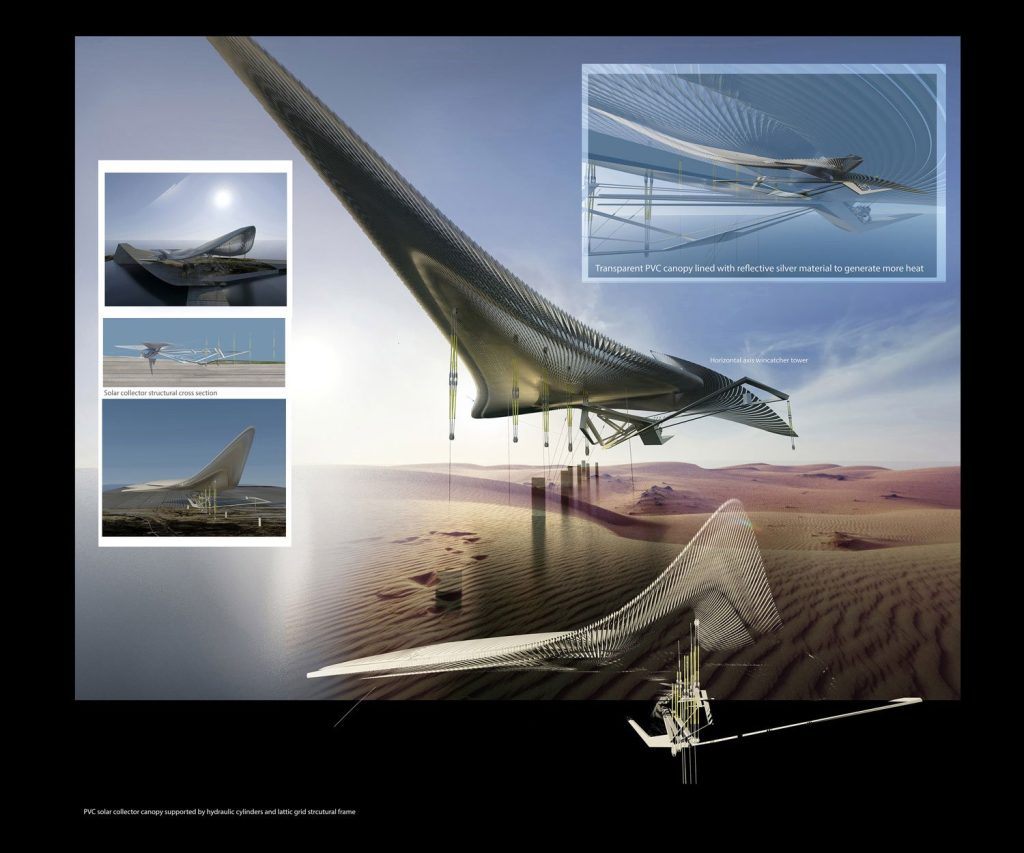
Due to the desert’s arid environment, we identified and used four areas of direction as part of the design criteria, which include windcatcher towers for ventilation and to assist evaporative cooling, solar collectors for high to low-frequency radiation conversion, and a Qanat infrastructure to further service agricultural irrigation efforts and building interior cooling methods.
The hotel provides shelter as well as a hospitable environment in a varied and environmentally unpredictable landscape. The temperature fluctuations and environmental diversity make it a challenge to survive comfortably, which led us to refer to ancient Persian technological methods of survival using aquifers and water wells to transport water across the desert, introducing water as fountains and interior pools in the hotel’s atrium and subterrain, which would use evaporative cooling to lower the temperature throughout the desert hotel.
The striated towers rise tall above the cooler desert floor catching warm air and transporting it into the hotel’s lower ground floor, which cools the air as it passes over pools of water using evaporative cooling. A PVC solar collector canopy is suspended over one of the hotel’s atrium pools made from PVC the complex cylindrical sections that have a reflective inner surface. This allows for the canopy to rise higher above the desert floor, in turn collecting condensation.
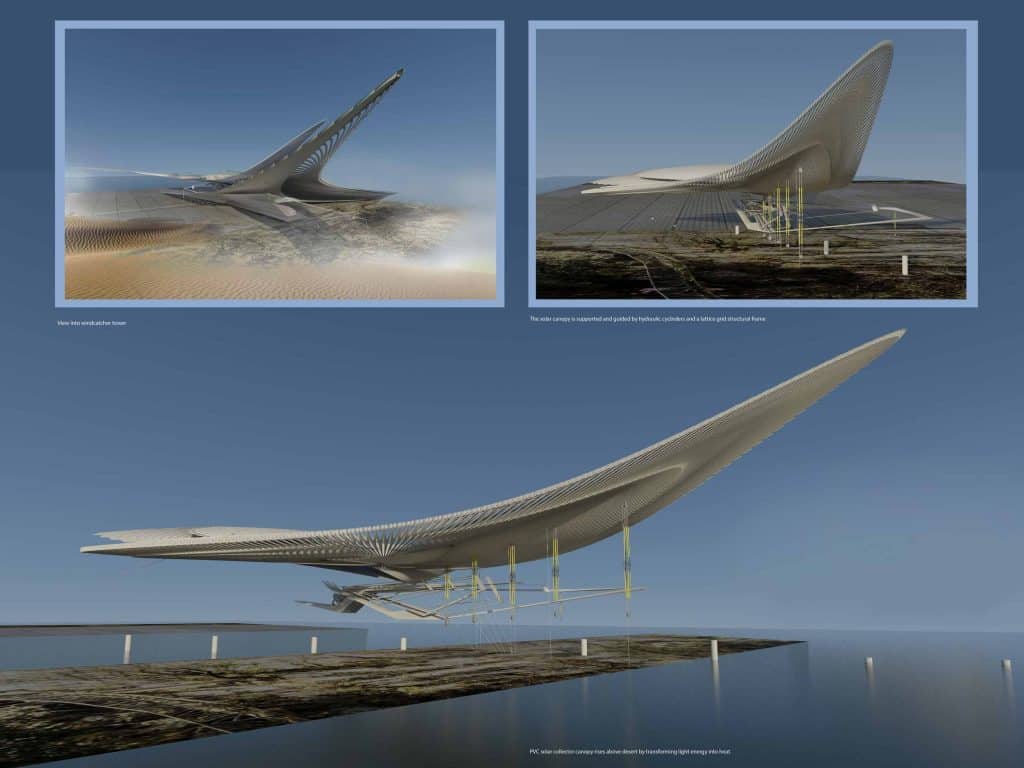
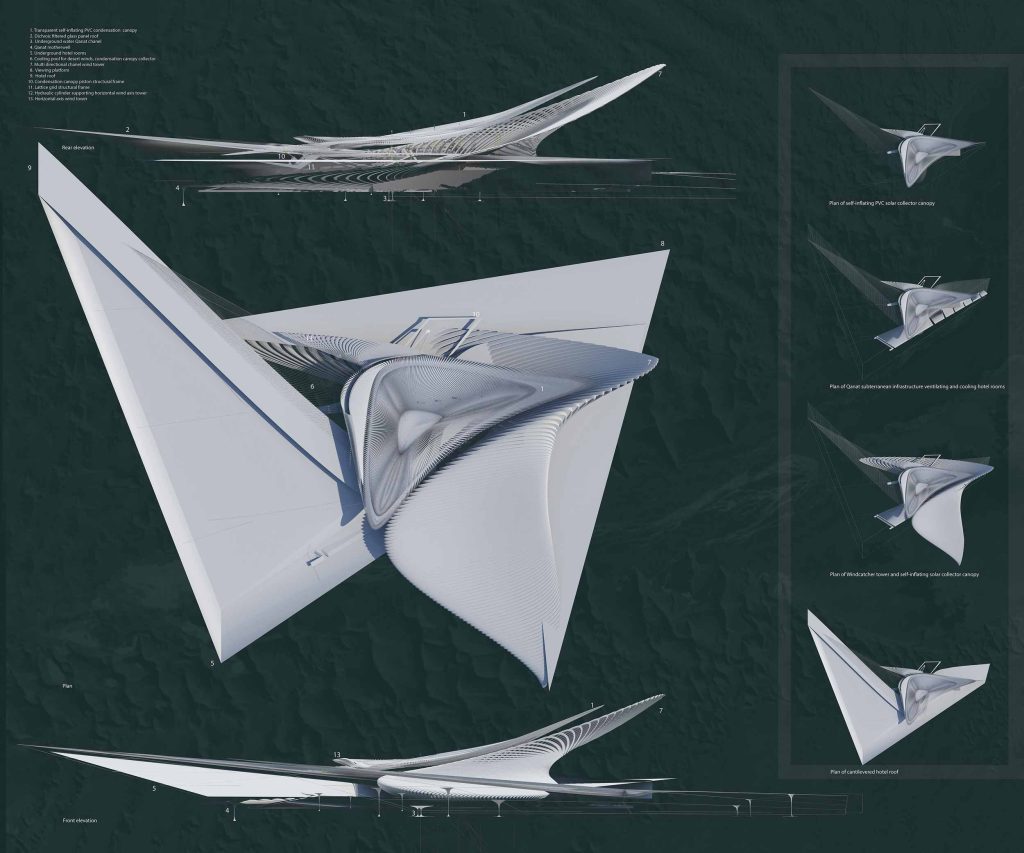
This condensation is then released into the evaporation pool below it whilst transforming high-frequency radiation into low, i.e., light energy from solar turns into heat, which expands the air trapped in the PVC solar collector making it rise from the ground to provide shelter from the sun and generate electrical currents using photovoltaic cells and piezoelectric cells.
The lower ground hotel vaults ventilation system is controlled/directed by the PVC canopy and the windcatcher towers above ground. The pneumatic PVC canopy rises and falls in the process, channelling the wind throughout the hotel. The canopy can also be choreographed by the wind tower which collects condensation from the desert air, filling the underground reservoir and pools to aid with evaporative cooling in the hotel’s atrium, whilst the windcatcher tower is clad in striated flexible aluminium and GFRP (glass fiber reinforced panels) material in order to capture multi-directional wind flow.
The design also uses an ancient Persian water supply system called a Qanat. Qanats are a series of well-like vertical shafts, connected by a gently sloping tunnel delivering water efficiently over large amounts of subterranean water to the ground surface without the need for pumping. The water drains by gravity, typically from an upland aquifer, with the destination lower than the source. Qanats transport water over long distances in hot dry climates without much evaporative water loss, making desert cultivation achievable. The intention of this project is to programmatically support by being a part of the irrigation and ecological infrastructure in Makran. The qanat system is economical and sustainable for irrigation and agricultural purposes.
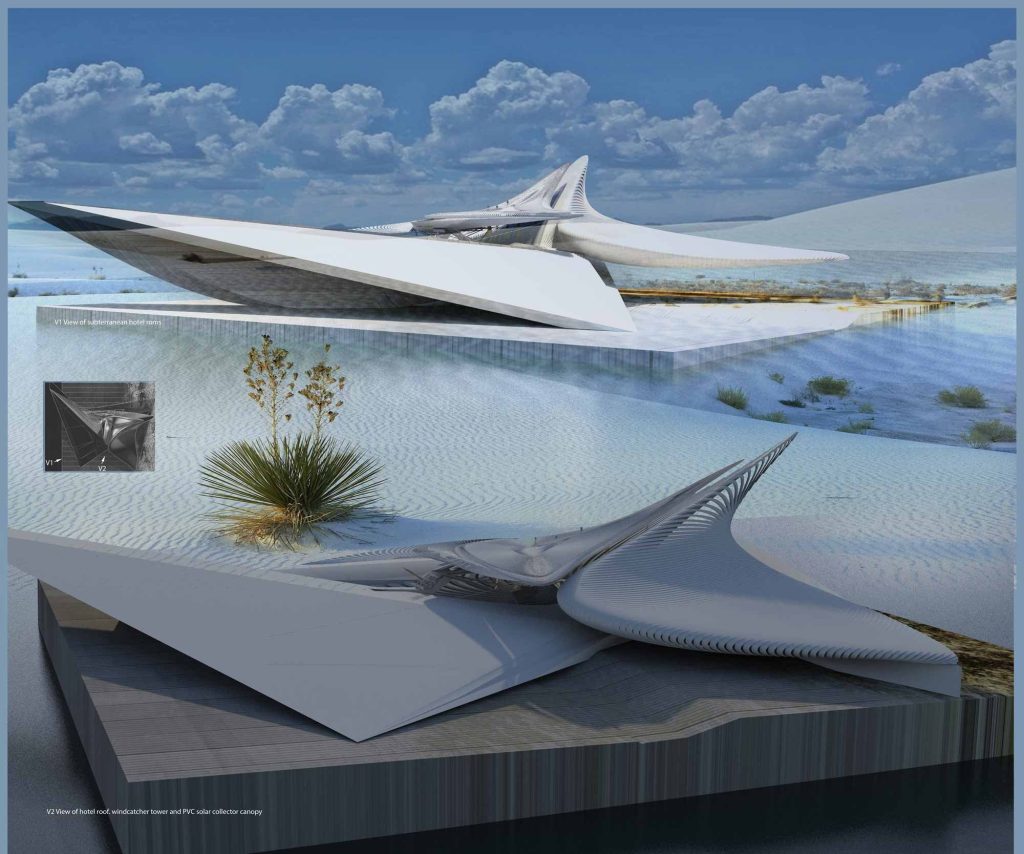
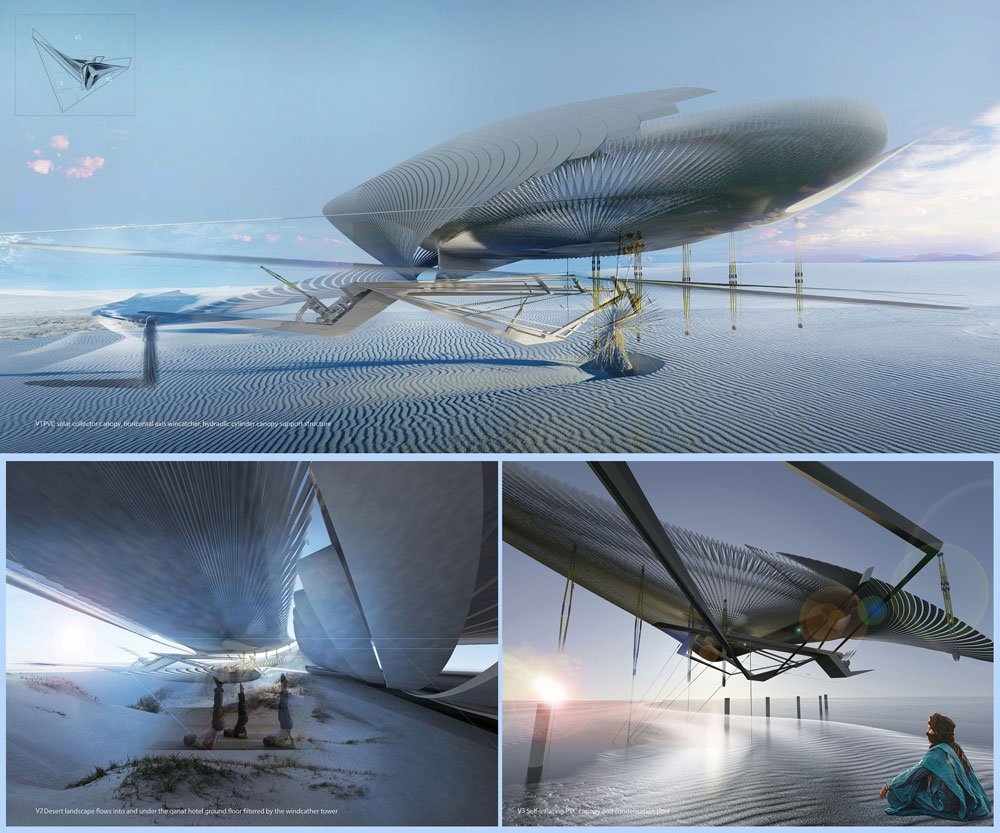
The hotel is located on the route of an existing yet redundant qanat with the aim to restore its efficiency and use, enabling the immediate environmental context to become agricultural land whilst also flowing underneath the hotel, which further cools and ventilates warm desert air directed into the lower area of the hotel by the windcatcher tower. A qanat can traverse long distances, reaching less populated areas, and the hotel encourages this by distributing water throughout its own qanat premises with channels travelling further into the desert with the aim to provide more agricultural settlements in more remote areas. This has an urban scale impact, by comparison, to solely satisfying its immediate context and hotel programme.
The employment of solar energy is a logical response to the brief due to the hotel’s location. We designed a geometrically complex transparent PVC solar collector canopy made from a series of cylindrical collectors (with reference and great respect to architect Graham Stevens and his desert cloud design for Kuwait in 1976) in order to increase surface area to more efficiently absorb and convert light energy into heat.
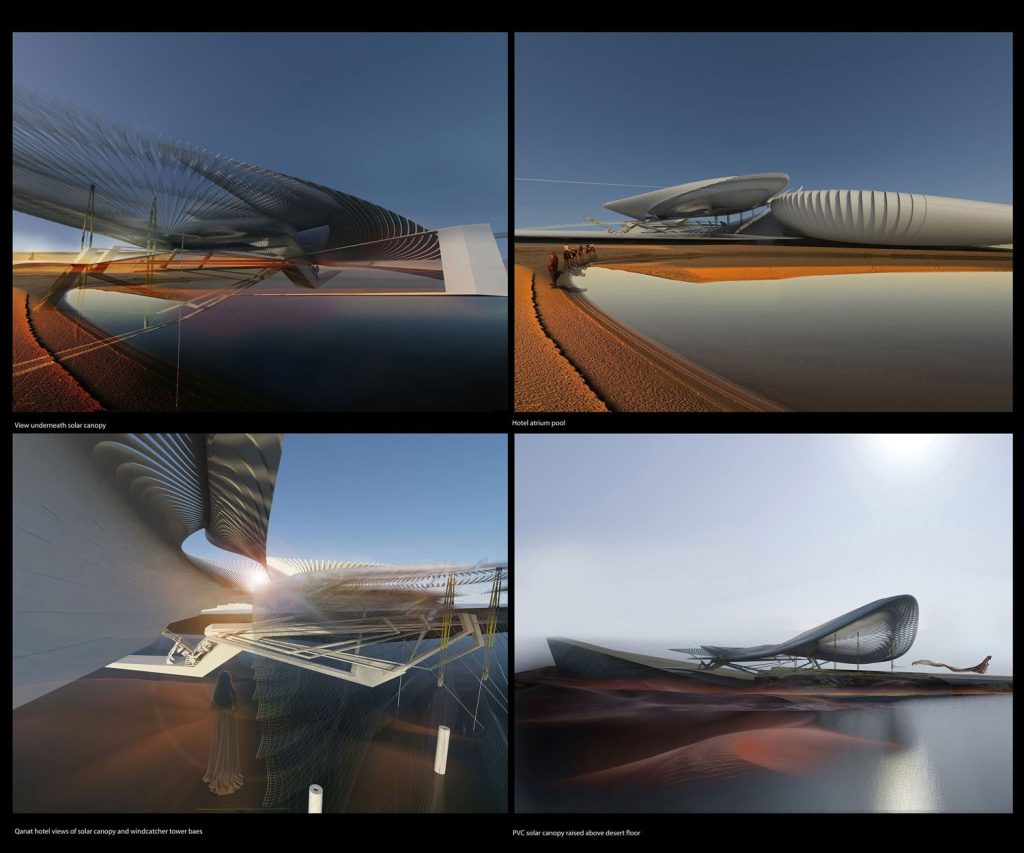
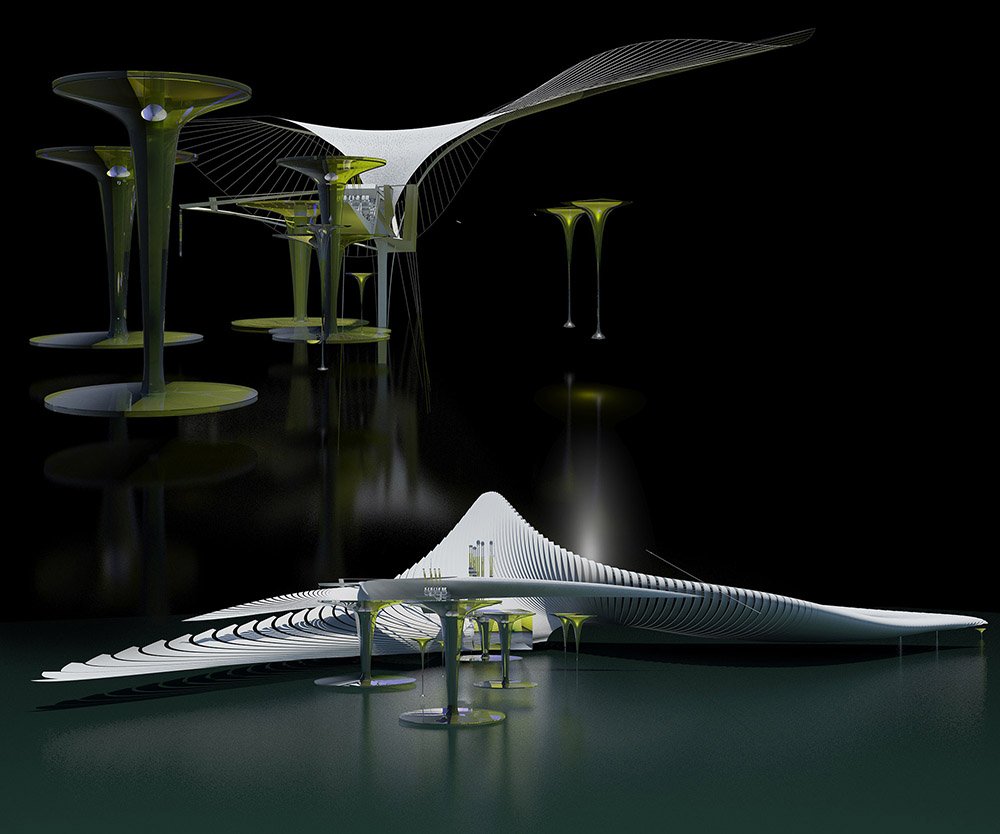
The inner surface of the PVC solar collector canopy is lined with highly reflective silver metalised polyester to increase the amount of absorbed light energy, and in turn, its conversion into heat within the canopy, prompting the canopy to elevate rising above the desert and trapping condensation, which is filtered into the atrium pool beneath it as well as harnessing more solar energy to convert into electricity using photovoltaics and piezoelectric cells embedded within the canopy.
The design is influenced by tent structures used by desert nomads as well as semiconductors and current technological advances in micro conductors. The canopy is tethered to the ground yet gently drifts and shifts in the current, supported by hydraulic cylinders acting as stanchions since they move with the pressure exerted by the canopy’s internal pressure and temperature.
The hotel rooms are partly buried in the desert and open to the vaulted underground atriums. Natural light enters through the punctured roof, which is a viewing platform, and gathering space is positioned around the floating canopy. Long corridors pass cooled air through them, creating cooler temperatures and shelter from the harsh desert sun. The qanat runs underneath the hotel room with well like openings dotted around the corridors. This is one of the hotels that features seeing the water drift gently through the desert subterrain.
